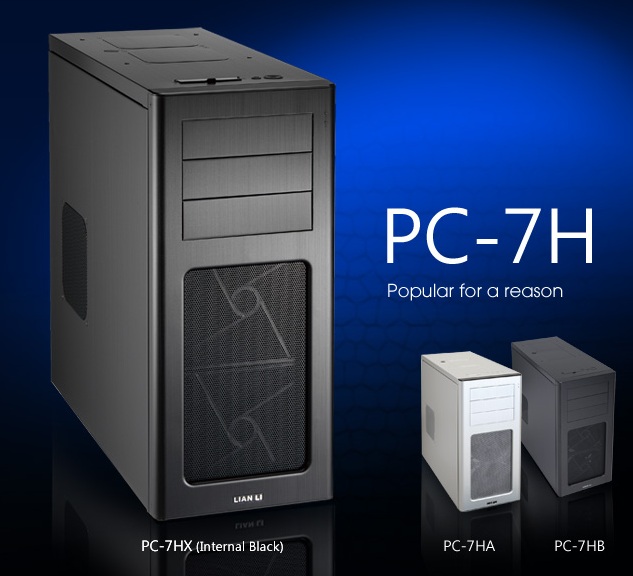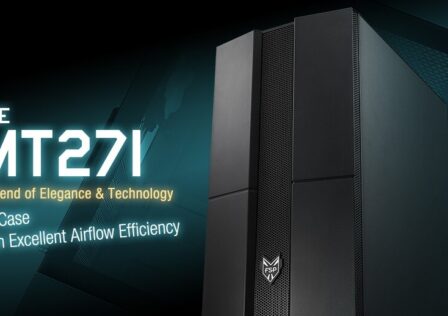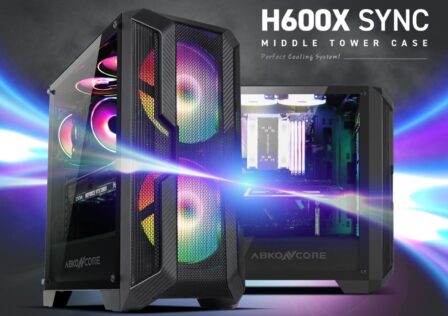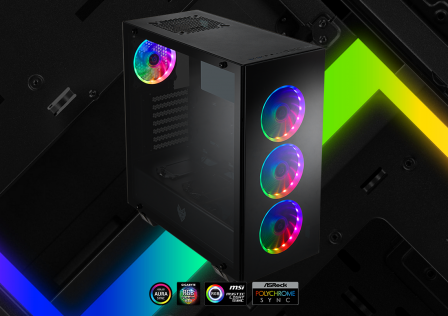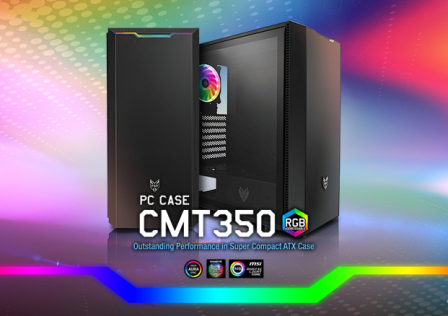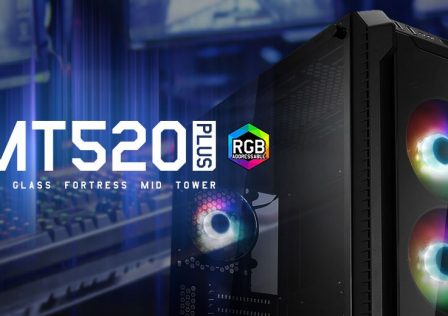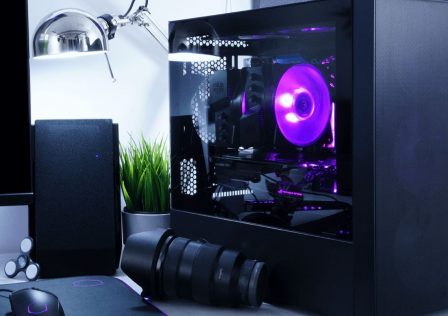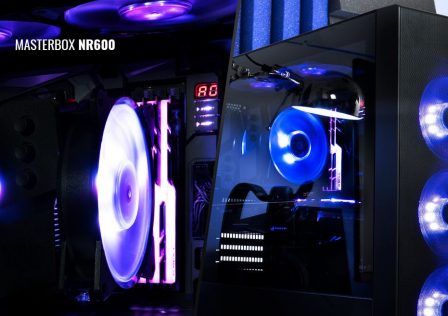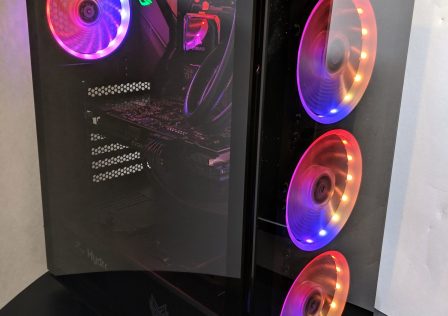Today’s a special day, everyone! Another manufacturer has stepped up to our plate: this is our first ever review on a Lian-Li product, well known for making quality cases that rise beyond the competition. What we have here is a fine specimen, the PC-7H, or more specifically, the PC-7HX. The X signifies a black interior. There’s also a PC-7HB, which is the same case but with an unpainted interior, and finally the PC-7HA which has a silver exterior. The PC-7H is an aluminum mid tower ATX case. I’ve been eager to review a Lian-Li case, so lets not waste anymore time.
Unboxing
The Lian-Li PC-7H is a mid tower ATX chassis made out of aluminum. Lian-Li is renowned for their build quality; you don’t find any unwanted plastic on their cases, and even their steel cases sold under the Lancool brand are much more sturdy than the competition. The PC-7H measures 210mm (W) x 473mm (H) x 490mm (D) and has a weight of only 5.8 kilograms, or just under 13 pounds. So this is a very light case, much lighter than most cases in this size since those tend to have a steel frame and plastic body. These specs and others can be found on the plain brown box that the PC-7H is packaged in.
There are no surprises inside the box. You’ll find the case wrapped in protective plastic, with padded foam on the top and bottom panels. This is how most cases are shipped, and I have no complaints whatsoever. The manual is in the box as well.
Inside the case, you’ll find this accessory box.
The accessory box contains all the screws and thumbscrews you need for assembling the case, but sadly no cable ties are included.
Let’s move onto the next page to see what this case really looks like.
Closer Look – Exterior
Lian-Li is known primarily for their clean, sophisticated styling. The PC-7H isn’t much of an exception, though the side vent makes it resemble cheap cases like the old Antec 300, therefore bringing back awful nightmares… anyway the entire case has a brushed finish (not easily visible in the below two pictures), which is easily my favorite finish for a case. Sadly it attracts fingerprints easily.
So now let’s go over the exterior features and functionality. On the top of the case, you’ll find two sealed 120mm fan mounts, something Lian-Li has been doing with their newer cases (I first saw it on the PC-V2120). There is a very thick aluminum plate over each one, which is held down by four screws. Sadly there are no fan grills included with the case, so you must use your own if you wish to use top fans. Lian-Li also sells an aftermarket top fan cover, which is ideal for a top mounted water cooling radiator.
You’ll also find the covered I/O panel, power, and reset buttons on the top. The I/O panel includes two USB 3.0 ports and audio ports. A USB 3.0 to 2.0 adapter is included. I have to mention, the top panel isn’t nearly as thick as my old Cooler Master ATCS 840 (which was also aluminum), but it gets the job done.
Now let’s look at the front panel. The HDD activity and power LEDs are located on the upper right hand corner, as with most Lian-Li cases. There are three optical drive bay covers and lots of mesh for the two 140mm intake fans. A Lian-Li logo completes this panel at the bottom.
The aforementioned HDD activity and power LEDs.
Lian-Li has the best front panel design in the market. They’ve used this design for so many years, and everyone loves it. To remove the front panel, you just have to pull it off; it is attached on all four corners. Although lots of cases these days are like that, Lian-Li was one of the first, and their design is still superior to all others. It’s fool-proof and you can’t break any small plastic tabs or anything, which is something I’ve seen on other cases with a pull-off front panel.
As you can see, removing the front panel reveals a dust filter for each of the 140mm fans, and this must be done to remove the optical drive bay covers. This means that the drive bay covers don’t wobble like in other cases, and accessing the dust filters is extremely easy. You can also see that the front fans are mounted with thick anti-vibration dampeners. The filters are washable.
If you look closely at the four corners where the front panel attaches, you’ll see a bit of Lian-Li’s unrivaled attention to detail. Plastic grommets are included here, to avoid unwanted metal-on-metal contact.
What’s missing from the front however is a fan controller. It’s an optional addon.
The right side panel is bare, while the left has ventilation for an optional 120mm fan. No dust filter is present for this vent, and surprisingly you can use a 120mm x 25mm fan here even with large CPU coolers. The side panels are much thicker than any case I’ve seen, which is especially necessary here since they’re aluminum.
Moving on to the back panel, you’ll find a 120mm exhaust fan which has a black fan grill on both sides. I wish more cases would have a removable grill on the back, it makes it much easier to clean the fan blades, and is better for external water cooling. Below this fan there are two stiff holes for water cooling tubes to pass through, and the case has eight ventilated expansion slots. The PSU installs in the bottom, and you can mount it either way. There are two thumbscrews for each side panel, like most cases these days. Sadly you won’t find Lian-Li’s unrivaled side panel mechanism here. The left side panel has an indent so you can attach a piece, which would let you lock the side panel with an optional lock. But sadly this piece isn’t included.
The side panel screws have rubber anti-vibration grommets. Lian-Li’s unrivaled attention to detail strikes again.
The last thing we’ll look at before moving to the interior is the bottom panel. It uses four feet which are completely engulfed in rubber padding. I was hoping for home-theater style feet (since Lian-Li’s patented top quality casters are only for their top of the line cases), but these will suffice. There is also a locker-style vent on this panel for the PSU, and a washable dust filter is present. I don’t understand why Lian-Li continues this filter design; you have to turn the case sideways like this in order to remove the filter. Most cases these days have a filter that slides out from the back, Lian-Li should adopt this method.
And now we shall look at the interior of the PC-7H.
Closer Look – Interior
The model we have today is the Lian-Li PC-7HX. As I mentioned earlier, this one has a black interior, but you can also get the PC-7HB if you want a black exterior and unpainted interior. For those who prefer silver, there’s the PC-7HA which has a silver exterior. So now we will take a closer look at the interior features of the PC-7H.
Here’s the hard drive cage located at the lower front. You can install up to four 3.5″ drives inside of it, and a 2.5″ drive on top. Installing drives is very simple as you’ll see later; for 3.5″, just slip four of the included rubberized thumbscrews on the sides, and slide it into place. For 2.5″, screw the drive in the top slot. Sadly there aren’t any adapters; by default you’re limited to one 2.5″ drive. This HDD cage is held in place by only several screws, so it can be removed, but Lian-Li really should have included two 120mm fan mounts on the bottom, for a second 240mm radiator.
Lian-Li is probably the only manufacturer with metal tool-free designs (excluding thumbscrews of course). You can store up to three optical drives, and the top two slots have the best tool free design on the market. Push the lever back to open this aluminum bar, slide the drive into place, and snap it closed. It even has rubber anti-vibration padding. The bottom 5.25″ slot has no tool free design, and note that installing a drive into the top slot can be tricky due to wires getting in the way.
Each of the eight ventilated expansion slots is secured with thumbscrews. This is ideal, as they don’t require a screwdriver and they aren’t unreliable like some tool free designs I’ve seen.
The PSU is installed on the bottom. It sits on two rubberized rests, over a locker-styled vent. Unless you’re on carpet, you’ll want the PSU’s fan to face down toward this vent, unless of course your PSU doesn’t have an overhead fan. Lian-Li did not include their tool free, rubberized metal locking bar for the PSU.
Turning the case around, you won’t find any punchouts on the motherboard tray that allow you to secure cables. You also won’t find Lian-Li’s cable organizer, which seems to have disappeared from their cases. What a shame, both of these would have really come in handy since the case came with no zip ties, the organizer would have made up for it. I assembled this rig with only four zip ties. Having punchouts on the motherboard tray for zip ties helps tremendously, since now I had to secure all the cables either on the edge of the motherboard tray, on the edge of the drive bays, in vacant drive bays, and on the bottom as you’ll see later.
It’s hard to complain about the space given to you behind the motherboard tray. There’s at least a half inch behind the motherboard tray for cables, and much more on this side of the drive bays. Compared to the last case I reviewed, this is a dream come true.
That pretty much wraps up this section. Overall I’m pleased at the interior design. There are no sharp edges anywhere, and this case gives you a good amount of room behind the motherboard tray for cables. I do wish the motherboard tray had punchouts for zip ties, and the CPU backplate cut-out should be wider. Lets now look at the assembly process.
Assembly
The following components were installed into the Lian-Li PC-7HX for this review:
- EVGA P55 FTW motherboard (ATX)
- Intel Core i5 760 @ 4.2 GHz, 1.30625 VCore, 1.375 VTT
- Mushkin Enhanced Radioactive 2 x 4GB DDR3 1600
- EVGA GTX 680 FTW LE (10.5″ length)
- Antec TruePower New 750W PSU (almost entirely hardwired cables)
- ASUS Optical drive
- Intel 330 series 180GB SSD (2.5″ with 3.5″ adapter)
- Cooler Master TPC-812 w/ Delta FFB1212EH and Panaflo U1 push/pull
Here’s a shot of the case before assembly was completed. The CPU cooler and GPU fit with ease. Notice the shroud attached to the case, where the rear fan used to be located. This is because I don’t use a rear fan, as it would only hinder performance. But I had to attach that rear fan grill to something, so I attached it to the shroud.
And here’s the case in its completion. It looks sloppy, but that’s mostly because the case is quite open so all of the cables behind the drive bays are visible. Still, I had to leave some cables on the bottom due to a lack of space, since this isn’t a large case. The real problem is both the CPU cable and one fan wire, which had to be routed frontside and not behind the motherboard tray. Still, it’s much cleaner than the last case believe it or not. Small case + non-modular PSU = not very neat. I’ll also mention that the top cable management hole, that would normally be used for routing the 24-pin motherboard connector, is too high up. My cable wouldn’t reach the motherboard through here, but the way I routed it is just as good.
After temperature testing, which you’ll see on the next page, I installed two 120mm top fans to improve airflow. Since they include no extra fan grills, I used the two included on the rear fan since they’re black and fit well.
So I had to go out of my way and find an extra fan grill lying around my house, since the back vent was left open. I didn’t have any black ones, so now the back of my case is a bit mismatched, but whatever. Nobody sees the back anyway. The grill is attached to the fan shroud I mentioned earlier.
Performance
For performance tests, I used the stock airflow setup minus the rear fan, since that would hinder performance. So that leaves us with 2x 140mm front fans. I’ll list the hardware once again.
- EVGA P55 FTW motherboard (ATX)
- Intel Core i5 760 @ 4.2 GHz, 1.30625 VCore, 1.375 VTT
- Mushkin Enhanced Radioactive 2 x 4GB DDR3 1600
- EVGA GTX 680 FTW LE (10.5″ length)
- Antec TruePower New 750W PSU (almost entirely hardwired cables)
- ASUS Optical drive
- Intel 330 series 180GB SSD (2.5″ with 3.5″ adapter)
- Cooler Master TPC-812 w/ Delta FFB1212EH and Panaflo U1 push/pull
For testing, I ran 3DMark 11 on extreme preset since it tests the whole system more than any game will. I recorded max CPU temperature with RealTemp, and GPU temps with MSI Afterburner. I’ll also include one previous case, the RAIDMAX Raptor, for comparison.
In the PC-7H, CPU temps peaked at 61 degrees Celsius, while GPU peaked at a mere 48 degrees. In the old RAIDMAX Raptor, we see temps of 59 on the CPU and 51 on the GPU. So the PC-7H was able to keep GPU temps cooler, while CPU temps were a bit hotter. The Raptor had only one 120mm front intake fan, while the PC-7H has two 140mm front fans. On the other hand, the Raptor had dual 120mm exhaust fans while the PC-7H had none. After installing two Thermalright FDB 120mm fans (2000 RPM) on the top for exhaust, my GPU temps went down by 1-2 degrees while CPU temps lowered to 59.
Regarding noise, well my CPU cooler fans easily drowned out everything else. With my loud Delta fan unplugged, I still couldn’t hear the front fans. I don’t know the specs on the stock 140mm front fans, but if I had to guess, they’re around 1000 RPM give or take a few hundred. They’re quiet for sure.
Conclusion
The Lian-Li PC-7H lived up to my initial expectations. It was my first Lian-Li case and overall I’m pleased, and not disappointed. The build quality is great; no cheap plastic, no thin sheet metal, and Lian-Li’s unrivaled attention to detail continues into this case. Airflow is definitely good; there is nothing to restrict airflow to the GPU, and you can install up to 6 fans (or 5 if you have a large CPU cooler). The stock fans are quiet. The interior is loaded with good features, and cable management is pretty good for a small case. I wasn’t expecting that much room behind the motherboard tray, so that was a pleasant surprise. But the case isn’t perfect, it has some downsides as you’ll see below.
- Appearance: The PC-7H has Lian-Li’s traditional brushed aluminum finish and sophisticated styling. But I would have preferred either a solid side panel, windowed side panel, or different side ventilation. Having just a single vent for a side 120mm fan reminds me of cheaper cases, but that’s just me and one of my nitpicks. 19/20
- Construction: Lian-Li’s unrivaled attention to detail is obvious with this case, from rubber anti-vibration on the fans/side panel/drives, to the lack of sharp edges, or the entire front panel design is brilliant. I’ll just deduct a quarter of a point for the top panel being not as thick as I had hoped, but it isn’t thin enough to cause problems either. 20/20
- Performance: Stock airflow is good, far more than adequate for my highly overclocked i5 760 CPU and my GTX 680. The fans are also quiet. Multi-GPU setups would benefit from more fans. 17/20
- Functionality: The PC-7H has good overall functionality. Installation was quick and easy, the tool free designs are great. Cable management is good, especially the space behind the motherboard tray, but I do wish that the case had punchouts on the motherboard tray for zip ties, as well as more height so that you could route the CPU cable behind the motherboard tray. I also dislike the mounting system for the PSU fan filter; it should slide out the back. The lack of a side fan filter is a bit disappointing. I also find one cable management hole to be a bit too high and slightly out of place, but again that’s a small nitpick. For those who water cool, you shouldn’t be looking at a small mid tower case like this. 18/20
- Value: The MSRP for this case is $119.99. That puts it in line with much larger mid tower cases, that don’t have nearly the build quality of this one. It’s a tradeoff, for sure. 16/20
- Overall: 90/100

